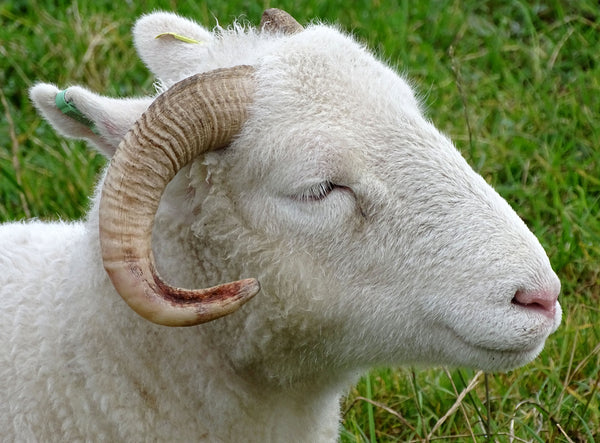Know Your Fiber: Whitefaced Woodland Wool
Posted on April 01 2020

The Whitefaced Woodland is a rare sheep breed that was once very popular in Northern England, but now is among the threatened breeds of sheep. It is hard to image why, though, because with their pink noses, white fleeces, and curled horns they sure are darn cute! Also sometimes called Penistone sheep, this breed originated in the Pennines Hills of northern England.
The Pennine Hills are a range that runs from north to south, directly through the Yorkshire region of England. These hills have been settled by humans for quite a long time, as demonstrated by archaeological finds that have included Neolithic stone circles and settlements, as well as Bronze Age settlements. Just how long sheep have been raised in the Pennines is up for debate, but if the area is anything like the rest of the British Isles it is safe to say that sheep have been raised there by humans since at least Neolithic times.
The town of Penistone, located in South Yorkshire, has very old roots. The first recorded mention of the town was in the 1086 Domesday Book as Pangeston/Pengestone – scholars think the name comes from Old Welsh, which would translate to something like Village on Top of a Hill. It was described as a “waste” in the Domesday Book, likely because the Norman Conquest had moved through that region in 1069 and destroyed many of the farms and settlements. However, farmers and villagers would return to the area to rebuild, creating new farms and a new town.
Sheep sales in Penistone have also had a long tradition, with the first chartered market for livestock having been established in 1290. Over time, however, neighboring villages took over the sheep markets, and it was not until 1699 that Penistone would regain its royal charter for a livestock market. It is around that same time that Penistone also started to become particularly well known for its sheep. Named after the town, Penistone sheep (the Whitefaced Woodland moniker would not be associated with the breed until later) were particularly admired during the 1700s and early 1800s for their ability to forage, their hardiness, and their meat. Their wool had a wide range of fineness, from fine to coarse, and during the intensive sheep breeding push of the late 1700s the Penistone breed would receive an infusion of genetics from other sheep, perhaps in an effort to produce a more consistent fleece. As a matter of fact, when King George III acquired his first Spanish Merino rams, he had the Duke of Devonshire put them to some of the Penistone ewes on his estates. Dual-breed sheep, sheep that could produce both good meat and good wool, were all the rage during this period. So, it is likely that the Duke’s breeding of Merinos with Penistones was an effort to improve upon their wool. Later in the 1700s, further attempts to improve the Penistone occurred. During this period the breed was likely also crossed with Scottish Blackface and Cheviot, perhaps in an effort to regain some hardiness lost during previous attempts at improvement.
By the early 1800s, these improved Penistones began to be referred to as the Whitefaced Woodland and became a significant source of wool in England. Admired for their particularly white wool, there was still a range in the fineness of wool that could be gotten from the Whitefaced Woodland. However, it appears to not have affected the demand for it at all, as it was used for hand yarn, clothing, blankets, carpets, and more. Interestingly, despite its admirers and popularity, a breed association was never established for the Whitefaced Woodland. Farmers in the Penistone and surrounding areas kept the breed alive but, like many breeds of traditional English sheep that were not suitable for industrial farming, the Whitefaced Woodland population began to seriously decline by the mid-1900s. Believing that the breed might become completely extinct, the Gene Bank established by the Zoological Society added genetic samples of the breed to their collection in 1964.
By 1980, there were only 14 flocks of Whitefaced Woodland left. Faced with the possible disappearance of this breed, the remaining farmers established the first ever Whitefaced Woodland Sheep Breeders Group in 1986. Since then, the breed has come back from the edge of extinction. However, with only around 900 breeding ewes reported as of 2016, the Whitefaced Woodland still has a way to go before it is no longer threatened.
With few farmers still raising Whitefaced Woodland sheep, the wool is still almost exclusively imported to North America from the Pennines and surrounding areas. The wool produced from the Whitefaced Woodland today is still beautifully white and ranges from 35-38 microns in width, putting it pretty solidly in the coarse range of wools. Staple length is around 4 inches, and it is not unusual for the wool to contain a little bit of kemp. It is a remarkably sturdy wool, perfect for hardwearing outerwear and rugs, as well as for felted projects that require a coarse and resilient, but easily feltable, wool. Since the kemp does not take up dye as well as the rest of the fleece, dyed Whitefaced Woodland wool can have a very attractive, almost tweed-like quality.
Ready to work with some Whitefaced Woodland? Check out our Whitefaced Woodland and other single breed wools in our shop!


Follow US